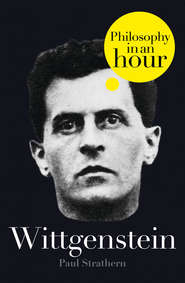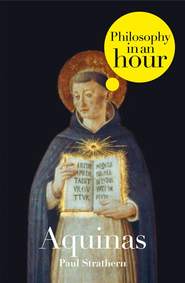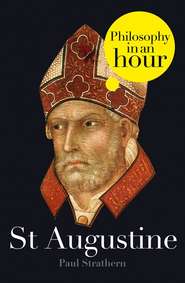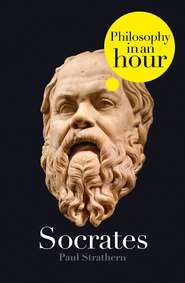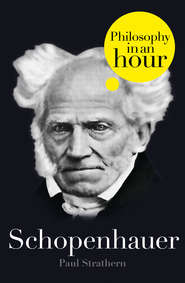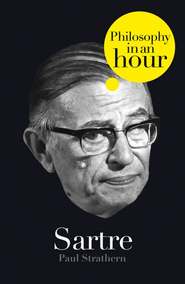По всем вопросам обращайтесь на: info@litportal.ru
(©) 2003-2024.
✖
Heidegger: Philosophy in an Hour
Настройки чтения
Размер шрифта
Высота строк
Поля
Paul Strathern
One of the two major philosophical traditions of the twentieth century was linguistic analysis, derived largely from Wittgenstein. The other, diametrically opposed, came from Heidegger, and its fundamental question was: ‘What is the meaning of existence?’ For Heidegger, this was not a query that could simply be ‘analysed away’ – it was beyond the reach of logic or reason. This was the primary ‘given’ of every individual life. To confront it, Heidegger needed to develop an entirely new form of philosophy.Here is a concise, expert account of Heidegger’s life and philosophical ideas, entertainingly written and easy to understand. Also included are selections from Heidegger’s work, suggested further reading and chronologies that place Heidegger in the context of the broader scheme of philosophy.
Heidegger
PHILOSOPHY IN AN HOUR
Paul Strathern
Contents
Cover (#udaaa32fe-deff-5aae-bc14-d4d0035b74ae)
Title Page (#u3a7d8ace-c4af-545b-93d7-95cb0e39687e)
Introduction (#u605eaf0c-76c4-5d4e-88c9-7fdf07892786)
Heidegger’s Life and Works (#u1c71fb61-3112-5cab-b8fb-17c590998e19)
Further Information (#litres_trial_promo)
Comments and Criticisms (#litres_trial_promo)
Chronology of Significant Philosophical Dates (#litres_trial_promo)
Chronology of Heidegger’s Life and Times (#litres_trial_promo)
Recommended Reading (#litres_trial_promo)
About the Author (#litres_trial_promo)
Copyright (#litres_trial_promo)
About the Publisher (#litres_trial_promo)
Introduction (#ulink_bef3110d-a2eb-5bfb-a9e8-b40a2ebd75ec)
Heidegger may have been the most controversial philosopher of the twentieth century. During the first half of that century the course of philosophy diverged as never before. There became, in fact, two philosophical traditions. These proved so incompatible that no discourse was possible between them. One regarded the other as sheer nonsense. The other regarded the former as having entirely missed the point of philosophy. Any reconciliation was out of the question.
On the one hand was the philosophy of linguistic analysis, which derived largely from Wittgenstein. As its name suggests, this philosophy required extreme rigour in the use of words. Philosophical problems were deemed to arise from the misapplication of words. In such cases, a word was used in a context to which it could not apply – which resulted in the ‘knot’ of a problem. As soon as the knot was untangled by suitable analysis, the problem simply vanished. For instance, take the question: ‘What is the meaning of existence?’ This was a question that simply could not be asked. And why not? Because to apply the term ‘meaning’ to the term ‘existence’ was invalid. For existence to have a meaning, this meaning would somehow have to exist above and beyond existence. But it is impossible for something to exist outside existence. Just as it is impossible for something to be red that is not red, true that is not true. Such analysis explains why there can be no answer to the question: ‘What is the meaning of existence?’
The other tradition of philosophy, which derived from Heidegger, was diametrically opposed to such analysis. Indeed, its fundamental question was: ‘What is being?’ In other words, ‘What does it mean to exist?’ or ‘What is the meaning of existence?’ For Heidegger and the existential tradition, this question could not simply be ‘analysed away’. Such questions were beyond the reach of logic or reason. They lay deeper. Our existence was fundamental: prior to rational thought or linguistic analysis. It was the primary ‘given’ of every individual life.
In order to ask such questions about being, about existence, an entire new form of philosophy had to be developed. This was what Heidegger saw as his lifelong task.
Heidegger’s Life and Works (#ulink_6aba4dae-3642-5318-9351-f98a6db4f37d)
Martin Heidegger was born on September 26, 1889, in the south German mountain village of Messkirch, just a dozen miles north of Lake Constance and the border with Switzerland. This was a pious rural area, where little had changed for centuries. Heidegger came from a background of small farmers and craftsmen. His father was a master cooper and sexton of the local Catholic church, his mother a farmer’s daughter from a neighbouring village. Martin showed an early interest in religion and seemed destined to join the priesthood. After high school he became a Jesuit novice, going to Freiburg University on a church scholarship in 1909 to study theology. But soon it became clear to him that his main interest was in philosophy, and after two years he switched to this subject. This was a brave decision, as it meant that he lost his church scholarship. But it was already evident to the university authorities that he had exceptional talent. He was given a small grant, which he supplemented by private tutoring.
In Heidegger’s school years there are no tales of escapades or the usual scrapes in which students become involved. Young Martin was intensely preoccupied with spiritual-philosophical questions. The earnest country boy was deeply unsettled by the manifestations of the modern urban world that he encountered in Freiburg. This may have been an out-of-the way provincial city, but the nearby Black Forest attracted a constant stream of cosmopolitan tourists. The citizens and students of Freiburg prided themselves on keeping up with the latest intellectual and social trends which were sweeping Germany. During the 1890s and 1900s the country was undergoing an astonishing transformation into a major industrial power. When German unification culminated in the founding of the German Empire in 1871, 70 percent of its population had been living on the land; by 1910 this had fallen to 40 percent. The old traditional rural Germany in which Heidegger had grown up had remained largely undisturbed since medieval times. Now it was giving way to modern cities where automobiles, electrification, and heavy industry prevailed. All aspects of Western culture were becoming urbanised.
Philosophy too was undergoing an analogous crisis. Since the beginning of the nineteenth century, Germany had prided itself on providing the leading European philosophers, such as Kant and Hegel. They had produced all-embracing metaphysical systems which explained the world and everything in it, including humanity. In many ways these systems had begun to take the place of God. (It was Hegel, not Nietzsche, who first pronounced ‘God is dead’.) Such systems were a way of viewing how the world worked. They were grounded in metaphysics – that is, in beliefs and assumptions that lay beyond our experience of the physical world. (Metaphysics literally means ‘beyond physics’.) But the tradition of grand and immensely serious metaphysical systems like those conceived by Kant, Hegel, and even Schopenhauer had come to an end. Gleefully Nietzsche had exploded this inflated tradition of systematic philosophy with pinpricks of epigrammatic wit before scandalously dying of syphilitic insanity in 1900. For Hegel, ‘God is dead’ had been an insight; for Nietzsche it was the basis of his entire philosophy.
Since then the preeminence of philosophy had been undermined by science and its new sibling subject, psychology. (There is an illuminating analogy here between the contemporaneous process of art being undermined by photography.) For many, scientific truth had begun to supplant philosophic truth. In 1905 Einstein had produced his Special Theory of Relativity. In this, the long-standing philosophical problem of time was simply reduced to the fourth dimension in the space-time continuum. Philosophy had become mathematics. Worse was to come with quantum theory, also described by Einstein in 1905, where light could be regarded as both a particle and a wave. In other words, light was solid matter and an immaterial motion simultaneously. Scientific reality defied the basic rule of logic: the law of contradiction. (An entity is something, or it is not something: it cannot be both at the same time, or neither.) The entire notion of philosophy was based upon logic.
Many, including Einstein himself, saw this illogicality as just a temporary anomaly, which would soon be resolved. It was nothing more than a necessary mathematical sleight of hand needed to overcome apparently conflicting experimental evidence. After all, mathematics too surely depended upon logic.
Yet even if logic survived this onslaught, it faced another threat – this time from psychology. According to ‘psychologism’, as it came to be called, logic was not based upon universal rules, and thus it did not produce abstract irrefutable truths. As early as 1865 the English philosopher John Stuart Mill had declared that logic in fact ‘owes all its theoretical foundations to psychology’. The truths of psychology initially arose from self-observation and our personal experience of the world. This meant that the axioms upon which we base our thought must surely be no more than ‘generalisations from experience’. The law of contradiction was not a universal truth, it was simply the way human beings thought. Logic was rooted in our psychology. So what became of philosophy? Was our entire attempt to know the truth about ourselves and the world doomed?
The twenty-two-year-old Heidegger had turned to philosophy in order to reach beyond all that he found inadequate in theology. He had wished to discover a certainty in which to ground his resistance to all the bewildering and multiplying uncertainties of the modern urban technological world. But now even philosophy itself was coming to an accommodation with science and modernity. The trend was away from the lofty spirituality he sought, toward down-to-earth positivism. This attempted to eliminate all systems and remnants of metaphysics from philosophy. Only truths such as those of experience, scientific experiment, or mathematics were acceptable. All of these could be either demonstrated or proved.
The main modern philosophy that sought to resist this trend was phenomenology, whose leading exponent was the German philosopher Edmund Husserl. Early in his student days, Heidegger borrowed Husserl’s Logical Investigations from the university library. Reading this work proved nothing less than a revelation to him. He kept the book in his room for the next two years. (Evidently no one asked for it at the library.) Heidegger was so overwhelmed that he ‘read it again and again’. He even became obsessed with the physical actuality of the book itself: ‘The spell emanating from the work extended to the outer appearance of the sentence structure and the title page.’
Heidegger graduated in 1913 but continued with postgraduate studies at Freiburg. A year later Europe was plunged into a world war. This traumatic event was at first welcomed with almost universal enthusiasm. On both sides, thousands of young men rushed to volunteer. Columns of troops marching to the railway stations to embark for the front were pelted with flowers by cheering crowds – from Glasgow to Budapest, from St. Petersburg to Rome. Many, of all classes, who had sensed an emptiness in their lives, now found a meaning in emotional patriotism. But this was to be a war without glory, such as none had foreseen. Battle tactics as ancient as battle itself were used against modern weapons. Machine guns mowed down advancing lines of thousands upon thousands, gas warfare blinded and suffocated, entire resentful armies rotted in the mud of the trenches. The civilian population was kept largely oblivious of this, with life continuing as before. Meanwhile an entire era of class-stratified society, inspired by the certainties of ‘God and country’, formed by ‘a century of peace, progress, and prosperity’, was dying amidst a slaughter the like of which had never been seen before. (On the opening day of the Battle of the Somme there were almost sixty thousand casualties, a figure similar to the results when the first atomic bomb was dropped on Hiroshima forty years later. The Battle of the Somme would continue for another four and a half months.)
Heidegger was called to military service but found to have a weak heart. He was placed in the reserves and ended up back in Freiburg working as a mail censor, a cushy job which enabled him to continue with his philosophy. In 1915 he began teaching at the university. The twenty-six-year-old from the backwoods had now become a university lecturer embarking upon a respectable career, with high prospects. Though earnest and ‘spiritual’, he was also highly ambitious. In 1916 he became engaged to Elfride Petri, an independently minded economics student who came from a Prussian military family. Three months later they were married. By this time the famous Husserl had arrived as professor of philosophy at Freiburg, and Heidegger had become his assistant. Although phenomenology was hardly well known outside academic circles, it was already being seen as something more than just a new philosophy. This was a movement that might one day fill the ‘spiritual vacuum’ that many were beginning to discern at the heart of German culture. Such was Heidegger’s deep and perceptive understanding of Husserl’s phenomenology that the two quickly became close. The professor soon began looking upon his bright young assistant in recognisably paternal terms. Here perhaps was his eventual successor in the growing phenomenological movement.
Husserl was convinced that he had found the answer to ‘psychologism’ as well as to positivism’s attempt to reduce all ‘truth’ to scientific truth. It was not a matter of denying such claims but attacking them head-on. According to his analysis, such views might be true within their own realm, but they remained ultimately inadequate. Science and psychology were based upon experiments, which meant that they always remained to a certain extent inexact, unlike the precise truths of logic and mathematics. 2+2=4 precisely. There is not even a possibility that it might just be 4.000001: we know that even to a thousandth of a percent and beyond it is always correct. Compare this with the most precise measurements of the speed of light, which can now be calculated to well within a millionth of a percent. We accept the value of this constant as 186,000 miles per second, but we know that this can never be exactly correct, no matter how precise our measurements. Here Husserl was in agreement with Einstein, who maintained: ‘As far as the laws of mathematics refer to reality, they are not certain, and as far as they are certain, they do not refer to reality.’
For Husserl, the laws of mathematics were ideal, they existed a priori – that is to say, they existed before our experience, and regardless of our experience. Even if there were no human beings to experience it, two plus two would still equal four. There remained a categorical difference between these ideal laws and real laws (those we apprehend in reality). Admittedly, we first become aware of these ideal laws by experience. But a logical or mathematical law is not confirmed by any ‘feeling’ we may have when we experience it. We intuit it, and at once we realise that it is self-evident. When we see that 2+2=4, we somehow know it is true.
If psychologism was correct, this would mean that 2+2=4 would not be incontrovertible. It would simply arise from one’s personal intuition of the world. Others might intuit it differently – and we would have no grounds for refuting them.
Husserl used the example of geometry, which he considered the most absolute and incontrovertible of all mathematical knowledge. The entire edifice of geometry was built upon a foundation that consisted of such basic concepts as ‘line’, ‘distance’, ‘point’, and so forth. According to Husserl, there was certainly an actual day in prehistoric time when particular individuals must have had intuitions of these concepts. In the midst of the flow of his experience, a particular primitive human being suddenly intuited the idea of a ‘point’. Later, another understood the concept of ‘line’. But once understood, these concepts had a precise and undeniable meaning. The rest of geometry consisted simply of exploring the logical implications that arose from these basic concepts. For instance, if we have one line, it is possible to have two lines, or even three. If these three lines are joined so as to enclose a space, they will form a figure with three angles: a triangle. This is necessarily true, and could not be otherwise. It had always been true, and always would be. Geometry did not contain these truths, they were ‘already there’, simply waiting to be discovered. This was the same with all mathematics, all logic, all absolute knowledge. They somehow existed beyond reality, beyond the inexactitudes and uncertainties of everyday life. They existed in a realm of their own. There was a ‘presence’ where absolute truth existed – the only alternative would have been an ‘absence’. Such a ‘presence’ guaranteed all absolute truth by its very existence.
Husserl’s ‘presence’ bears a strong resemblance to an unseen all-seeing God, whose existence guarantees all truth. Indeed, at the outset of his career Husserl had stated that his aim was ‘to find the way to God and to a truthful life through strict philosophical scholarship’.
But to find this way by philosophical means it was necessary to study the one subject whose truth was closest to us – namely ourselves, humanity itself. Here too there was a similar division between the uncertainties of reality and absolute truth. In Husserl’s view, the essential study of humanity, the true subject of philosophy, lay far beyond the reach of science or psychology. His phenomenology proposed a ‘philosophy of Absolute Being’ which arose in a ‘universally true’ consciousness. Here was where philosophy originated, beyond even the need for any fundamental presuppositions, such as were required by logic. Here was the ultimate philosophy, which existed of its own accord. But how was it possible to reach this ‘pure’ and ‘universally true’ consciousness? Evidently this was not possible by means of scientific or even logical methods. It could only be achieved by using a phenomenological approach that Husserl called ‘reduction’.
Reduction involved concentrating upon consciousness and eliminating any attention to particulars by ‘bracketing them out’. In this way one would be left with pure consciousness, with the ‘essential, universal structure of the mind’. First, one ‘bracketed out’ reality. As Husserl pointed out, reality consists of real objects, but these objects are not objects in consciousness itself. They exist outside consciousness in the real world – where they are best studied by scientific means. Second, it was necessary to ‘bracket out’ the objects and acts of consciousness itself. As we have seen, these objects were not the objects of reality itself, they were representations of this reality. They appeared in our consciousness through acts of consciousness, such as memory and perception. Similar acts of consciousness included judging, analysing, contemplating, and so forth. These too could be ‘bracketed out’. We are then left with consciousness itself – ‘pure’ consciousness – the unifying realm where all our awareness takes place. At this point we experience the ‘origin-immune’ truth of our ‘primal givenness’ (in the sense that awareness is given to us). In this way we are aware of a ‘transcendental ego’ which is ‘universally true’ and is thus part of an ‘Absolute Being’.
Heidegger initially accepted Husserl’s analysis but soon began to modify it with ideas of his own. This would be the beginning of his original philosophy – nonetheless it would remain heavily indebted to Husserl’s phenomenological approach.
In 1918 Heidegger was called up and dispatched to a meteorological unit outside Sedan in German-occupied eastern France. By now the German army was beginning to disintegrate as the Allies advanced. Heidegger took part in no actual fighting but was deeply affected by the historical events unfolding around him. In rapid succession the kaiser abdicated and fled to Holland, Germany became a republic under a Social Democratic government, and the German army surrendered. A humiliated Germany was faced with political chaos: the navy mutinied in the northern ports while Berlin and Munich were in tumult. Heidegger recognised that the entire pre-war way of life – its culture and its bourgeois self-belief – was gone forever. Echoing his belief in phenomenology, he felt nothing was left to him but the ‘force of personality or belief in the intrinsic value of belonging to the central ego’. Yet paradoxically he could not help but feel ‘a pleasure to be alive’, happy that a world that had ‘merely played with the spirit’ was now coming to an end. The future held the promise of a ‘new era of spirit’. Others throughout Germany, imbued with similar spirit, had a different take on affairs. In imitation of Lenin’s Bolsheviks in Russia, the south German state of Bavaria declared itself an independent Communist republic. The Spartacists led a revolt in Berlin with the aim of establishing a similar ‘red republic’. Both were soon crushed by the right-wing ‘Freikorps’ (free soldiers), and the Red Terror was followed by a White Terror. Meanwhile the Allied blockade continued, and many began to go hungry.
Вы ознакомились с фрагментом книги.
Приобретайте полный текст книги у нашего партнера:
Приобретайте полный текст книги у нашего партнера:






